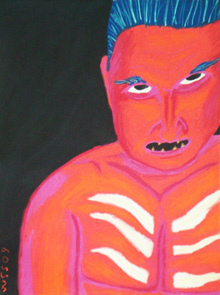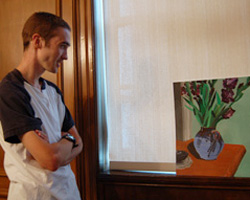People
August 25, 2010
Autism Center expands outreach through art, volunteerism

Artist Westley Strellis titled this pastel painting "Enemy in the Mirror."

Artist Andrew Grimes next to one of his works.
His face is flaming red, eyebrows furrowed, fang-like teeth exposed.
Artist Westley Strellis titled this pastel painting “Enemy in the Mirror,” his self-portrait.
Strellis has Asperger’s syndrome, a developmental disorder that affects his ability to get along in social settings. Painting gives the 24-year-old a voice, whether he is depicting an anthropomorphic statue or an abstract still life of mushrooms.
“Westley can’t tell you about his spectrum of feelings, but he can show you,” says his father, Keith.
Strellis and a dozen other participants in the Emory Autism Center’s Adult Services Program showcased their creative talents at the center’s first annual art show, held Aug. 1 in Harland Cinema.
Along with raising the profile of the center, which provides individualized services, family support and social skills workshops to Georgia residents with autism spectrum disorders, the exhibition reinforced a sense of value and camaraderie among the participants.
“Often, when people hear the word autism they think about the challenges associated with it rather than the strengths, talents and gifts,” says Toni Thomas, the center’s program manager for Family and Adult Services.
To encourage these adults to have an active social life, the Emory Autism Center is piloting a program with Emory pre-health and psychology students to offer weekly outings to play sports, watch movies or volunteer, along with providing assistance in locating independent housing and employment.
The program could begin this fall, depending on the level of student interest, and will give the center a much-needed base of regular volunteers while offering the students a hands-on, service-learning experience.
Previously, the center relied on community volunteers to fill the void. But center staff felt it was important to reach out to students with either an academic interest or technical expertise in dealing with adults with autism, says Omar Nazzal, a Duke University student who helped design the program while working as an intern at the center this summer.
In the meantime, Thomas hopes the art show will become an annual event, expanding the center’s community reach. This year’s lineup featured photographers, a comic book artist, a laser show producer and a published science fiction author signing copies of his novel, “But Whether Men Do,” which pits robots against man as a force for good.
Also making an appearance were 32 cyclists and support staff from the Pi Kappa Phi Fraternity, who 54 days in to their cross-country “Journey of Hope.” The annual fundraising event raises an estimated $500,000 for people with disabilities.
“One of the biggest benefits of the autism center is finding a community of people with similar challenges,” says Keith Strellis. “You realize that you are not alone on an island.”
